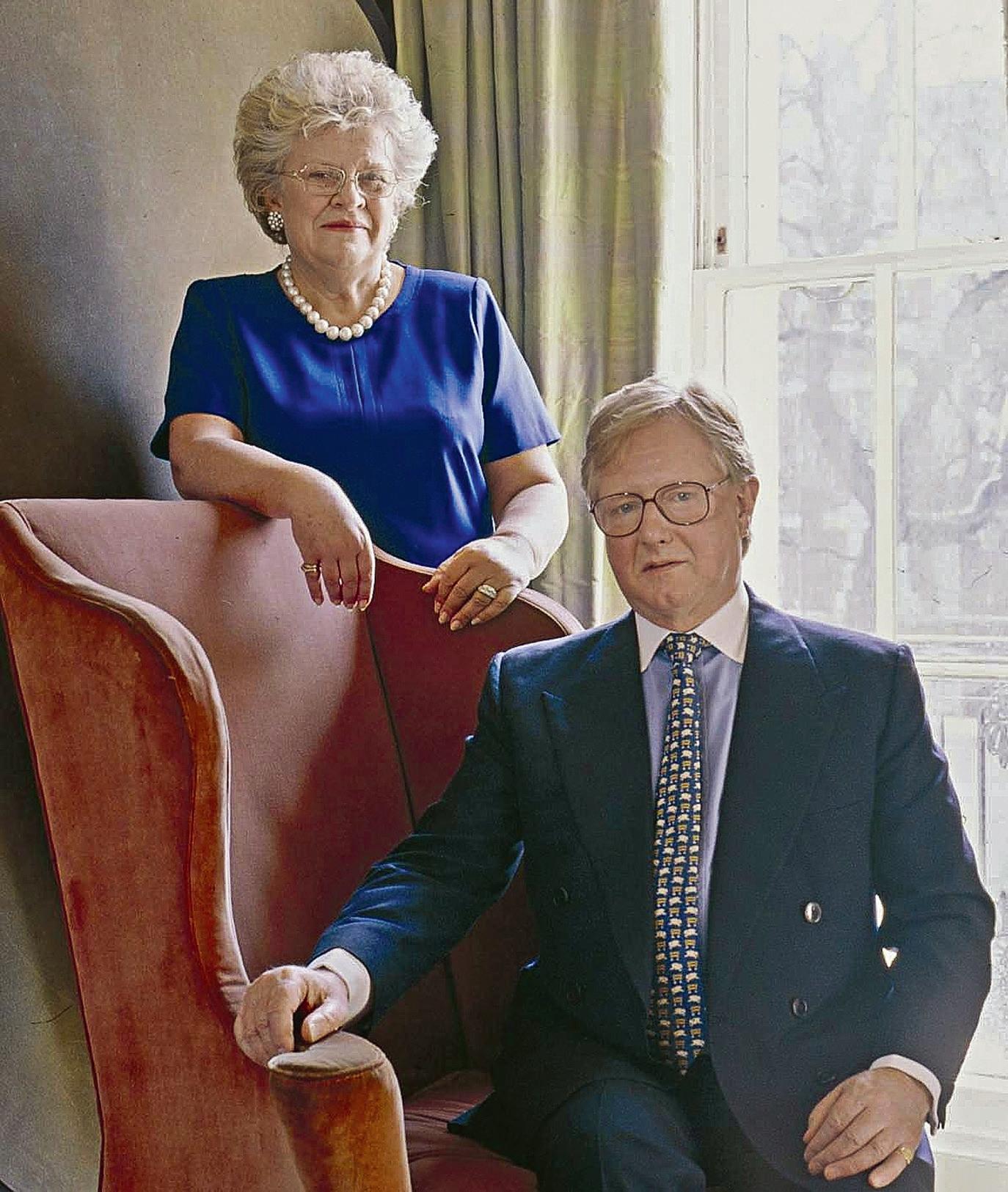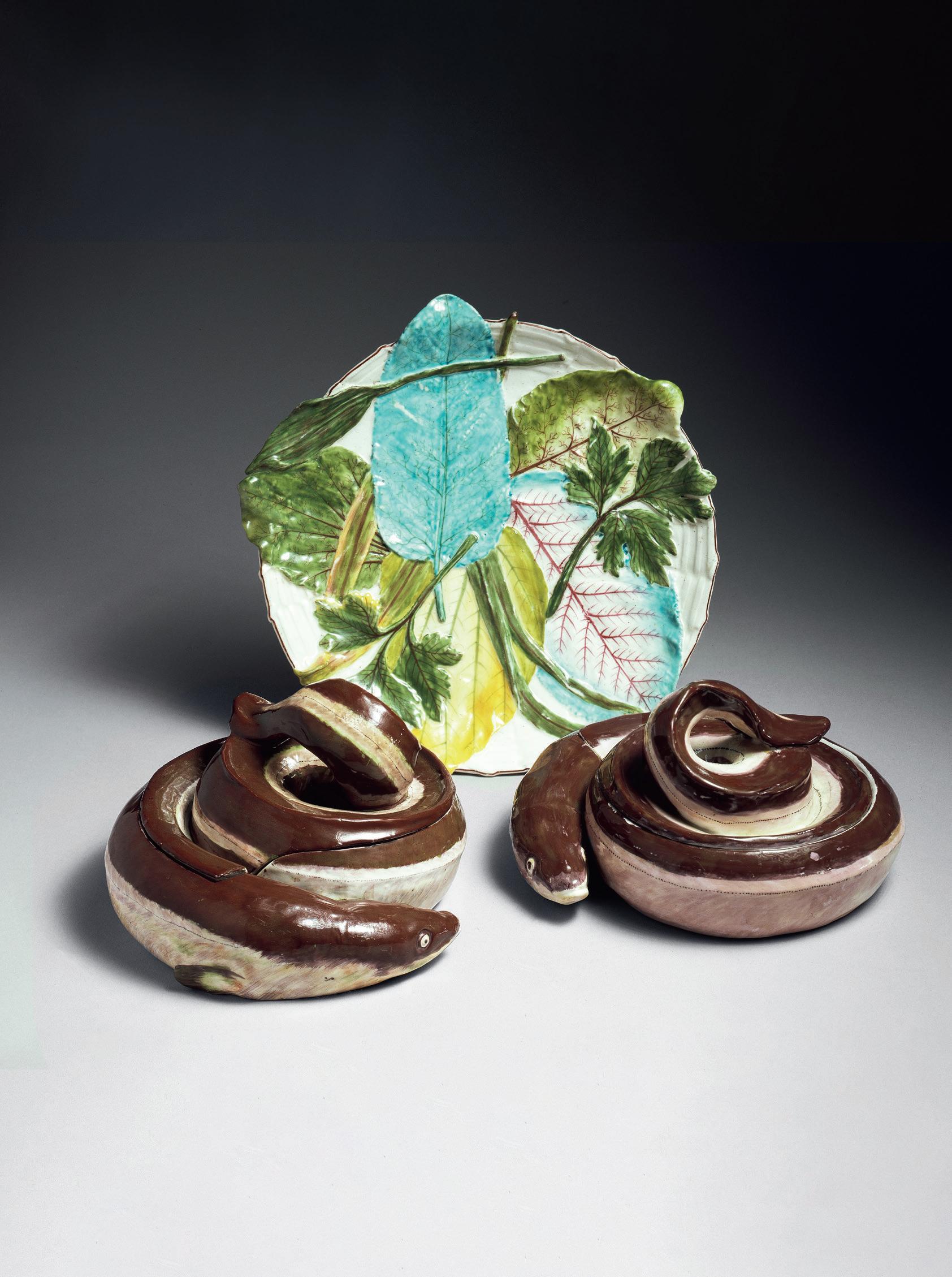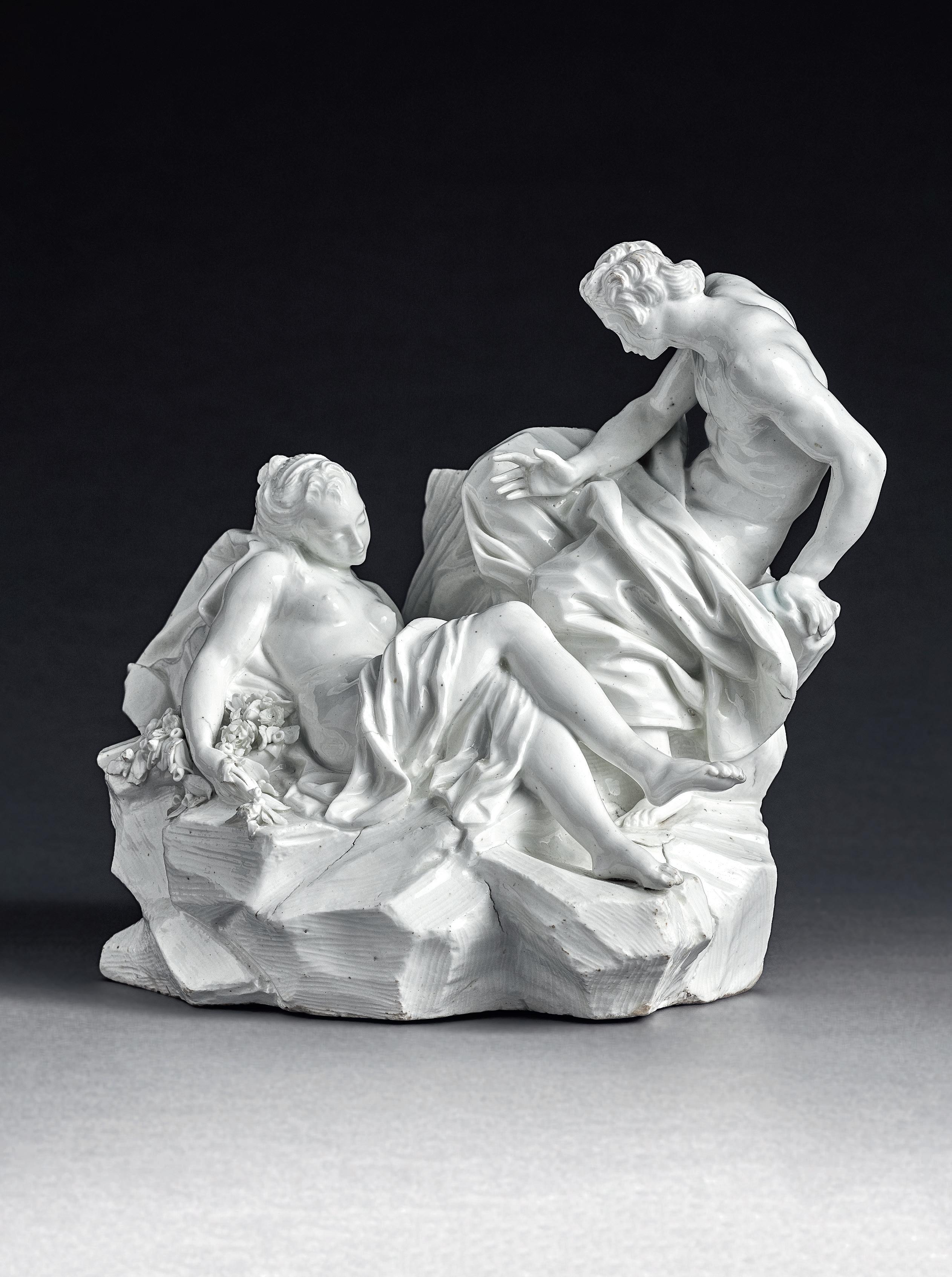The Man with the Butterfly Tie

Ceramics Essays in Honour of Brian Haughton




Foreword
A Celebration of Brian Haughton ROSALIND SAVILL AND MEREDITH CHILTON
Foxes, Fairs and Friends: An Early Bow Model of a Fox JULIE EMERSON
From Samarkand to Stratford-le-Bow: Tamerlane and the Sultana PATRICIA F. FERGUSON
Chelsea ‘Goat-and-Bee’ Jug J. V. G. MALLET
Inventive Hybridity: Two Chelsea Chinoiserie Teapots FRANCESCA VANKE
An Object with Many Facets PETER KAELLGREN
Plants of the Enlightenment on a Plate: The Timeless Allure of Chelsea’s Innovative
Soused and Collared: Chelsea Eels on the Rococo Table IVAN DAY
Drama and Delight at the June Fair ROSALIE WISE SHARP
‘Taking Tea with Dr Wall’: A Chinoiserie Moulded Early Worcester Teapot PAUL CRANE
The Beauty of English Chinoiserie FERGUS GAMBON
The Vauxhall Goatherd: A Curious Transformation ROGER MASSEY
Richard Chaffers’s Porcelain Statuette of John Milton: A Culmination of Collecting Eighteenth-Century Porcelain Sculpture at the Detroit Institute of Arts ALAN P. DARR
Of Cabbages – and Kings LETITIA ROBERTS
Exotic Pottery: The Pineapple in Staffordshire PAT HALFPENNY
Inspired Imitation JANINE E. SKERRY
A Pair of Magnificent Mason’s Hall Vases GAYE BLAKE-ROBERTS
A Cockerel with Something to Crow About HOWARD COUTTS
Privileged Pleasure: Kakiemon at Chantilly DANIEL CHEN
Gods of Good Fortune: A Pair of Chantilly Pot-Pourri Figures OLIVER FAIRCLOUGH
The Happiest of Shepherds: A Vincennes Masterpiece ROSALIND SAVILL
In Search of Blue: A Vincennes ‘bleu lapis’ Teapot ANTOINE D’ALBIS
A Parrot for a Duke? AILEEN DAWSON
A New Influence at Sèvres: A Pair of ‘Bouteille persane’ Vases TAMARA PRÉAUD
A Tournai Bust of a Man JEFFREY MUNGER
97 How to Shape European Porcelain: The First Assortment of the Meissen Manufactory JULIA WEBER
100 From China to Saxony: A Meissen Cadogan Pot RUTH SONJA SIMONIS
103 A Pair of Meissen ‘Feng’ Teapots WILLIAM R. SARGENT
106 What’s in a Name? An Armorial Meissen Footed Saucepan for Queen Maria Josepha MAUREEN CASSIDY-GEIGER
109 Best Friends at the Royal Dresden Court MELITTA KUNZE-KÖLLENSPERGER
112 A Snuffbox Tribute to Brian DEBORAH GAGE
115 Always a Warm Welcome KATHARINA HANTSCHMANN
118 Ice-Cream from an Etruscan Toiletry Case SAMUEL WITTWER
The Pinnacle of Style: A Pair of Fürstenberg Vases CHRISTIAN LECHELT
Antiquity for Dessert CLAUDIA LEHNER-JOBST
129 An Underwater World in Porcelain: A Striking Early Doccia Terrine ANDREINA D’AGLIANO
132 Giuseppe Gricci’s ‘Book and Print Seller’ in Porcelain from the Real Fabbrica di Capodimonte ANGELA CARÒLA-PERROTTI
135 Expertise and Fantasy: A Vessel from the Cozzi Manufactory ELISABETTA DAL CARLO
Frivolous Dwarfs ALESSANDRO BIANCALANA
Roman Souvenirs of a Modern Masterpiece OLIVA RUCELLAI
Porcelain and the European Taste for the Exotic SEBASTIAN KUHN
149 Masterpieces of Russian Porcelain – Ceremonial Vases with Picture Painting EKATERINA KHMELNITSKAYA
Magda Grigorian
Bernard Dragesco
Christophe Perlès
Leslie Greene Bowman
Linda Roth
Rose Kerr
Timothy Wilson
Diana Edwards
Justin Raccanello
Kate Malone
Timothy Schroder
Philippa Glanville
Martin P. Levy
Barbara Deisroth
Anna Somers Cocks, ‘The Art Newspaper’
The Haughton Fairs
Victoria Hooton and Marion Nunn
Edward Munves
Ian Wardropper
Alan Salz
Robert D. Mowry
Erik and Cornelia Thomsen
Japan Society Luncheon Tributes: Judy Price Alexandra Munroe and Vishakha N. Desai
Emma Jane Haughton Hay and Giles Haughton
Lesley J. Kehoe
Martha Vietor Glass
Georgina Gough
David J. Callaghan




This book celebrates the fortieth anniversary of the International Ceramics Fair and Seminar, first established in London in 1982 by Brian and Anna Haughton. It also recognises the remarkable contribution Brian Haughton has made to transform the art world by bringing together the international commercial, collecting and academ ic communities in a way that has integrated all three groups, enabling an extraordinary exchange of knowledge and passion which has benefited everyone, from amateurs to professionals and general art enthusiasts. For the past forty years, Brian’s life has been divided between his flagship London gallery and the international art fairs organised with his wife, Anna, and latterly with the aid of their children, Giles and Emma Jane.
To mark this special anniversary, forty noted ceramics scholars, dealers and collectors were invited to write about an object that was once sold by Brian. The criteria were that each author has lectured at one of the Haughton seminars and has a close personal connection to and affection for Anna and Brian. They have been immensely generous with their time and scholarship, and a number of them have completed their essays with words of tribute to Brian.
Also, to ensure that Brian’s broader impact is also celebrated, a wide range of participants at the Haughton fairs and seminars in London, New York and Dubai were invited to reminisce informally about their fond memories of these triumphant events. Their words reveal what could be called the Haughtons’ magic formula: an opportunity for the best of the world’s dealers to gather together and present their treasures for sale while also involving noted scholars, curators and collectors in par allel seminars, lectures and exhibitions. Hallmarks of the Haughton fairs included their quality and level of organisation, as well as the vigorous vetting protocols which were established from the very beginning.
Anna Haughton has led on this publication with her enthusiastic personal support, and we, Meredith Chilton, Rosalind Savill, Paul Crane and Daniel Chen, thank her for her dedication to the undertaking. We would also like to thank Giles Haughton, Emma Jane Haughton Hay, Mary Jones, the project editor Mary Scott, and Greta Garle, Wendy Brouwer and the team at arnoldsche Art Publishers, for their wholehearted participa tion and expertise, as well as the many others who have provided invaluable assistance.
On behalf of collectors, the ceramics community, the silver community and the fine and decorative arts world, we stand as witnesses to the remarkable achieve ments of Brian Haughton.
As a young curator and sole member of the Decorative Arts Department at the Seattle Art Museum (SAM) in the mid-1980s, the Interna tional Ceramics Fair and Seminar had an enormous influence on my career and the museum’s European porcelain collection. At the fair I first met Brian and Anna Haughton, museum colleagues, dealers, auctionhouse specialists and collectors, whose knowledge and support I have continually treasured. Daniel Chen of the Brian Haughton Gallery thoughtfully suggested that my contribution to this book should centre on this rare, early Bow model of a snarling Fox, c.1747–48. Brian acquired the Fox in 1988. It had formerly been in the Dudley Delevingne collection. The only other known model of this Fox is in the SAM collection. 1 The two examples have a white, frit-like paste, and both of them had slumped in the firing. SAM’s model, in particular, has badly bowed legs compared to Brian’s. They may have been produced during trial firings, since both date from the period when Bow was developing a new paste.
Martha Isaacson, Seattle’s premier collector of European porcelain, donated her Fox to SAM in 1969. Enthusiastically supported by her husband, Henry C. Isaacson, she began collecting around 1939 and became an early member of the Seattle Ceramic Society. The society was founded in the late 1930s by Blanche M. Harnan, a keen scholar of European porcelain, who inspired a group of lady friends to establish a reference library and to collect. They presented talks on their
favourite porcelain manufactories at monthly meet ings and formed an arrangement with New York dealer William H. Lautz, who sent regular shipments of porce lain for their consideration. A competitive spirit ensued as a barrel was unpacked and the members gathered round with what Martha Isaacson described as the excitement of ‘ladies at a bargain sale’. The barrels were always returned empty to Mr Lautz. In time, the society grew to include three study groups, known as units, with some members collecting well into the 1970s. The society’s goal of collecting museum-worthy pieces was clearly met – they held five exhibitions at SAM between 1949 and 1964. From the mid-1950s to 1976 the Isaacsons donated over 350 pieces of European porcelain to the museum, forming the bedrock of its collection. Addi tional objects from the Isaacson collection were later offered for sale by Armin Allen at the International Ceramics Fair in June 1989.
While Martha Isaacson, the wife of a Seattle steel magnate, was collecting Meissen and blue-scale Worces ter, society member Dorothy Condon Falknor, whose husband was Dean of the University of Washington School of Law, collected on a more modest scale but acquired some great rarities. Her three ‘A’-marked cups were included in her gift to the museum in 1987. They are from the first patent, dated 1744, of Edward Heylyn and Thomas Frye, whose experimentations led to the founding of the Bow manufactory, and predate the foxes by three or four years. The museum has two other

This plate from Nicholas Sprimont’s Chelsea por celain factory is painted with a spray of Sweet Flowering Bay, also known as Magnolia virgin iana or Sweet Bay Magnolia, an image which encapsu lates the whole pantheon of Enlightenment botanical research and its intrepid plant hunters, amateur bota nists and natural scientists.
The plant was illustrated in Mark Catesby’s pioneer ing work The Natural History of Carolina, Florida and the Bahama Islands, published from 1731, which explored the flora and fauna of those colonies.1 A drawing of the plant by the German botanical artist Georg Dionysius Ehret, now in the collection of the Earl of Derby, was published in reverse by Christoph Jacob Trew, a Nurem berg physician, lawyer and botanist, in his Plantae Selectae (1750–73, vol.1, pl.9). Ehret lived adjacent to the Chelsea Physic Garden, having married the sister-inlaw of Philip Miller, who had been appointed Curator of the garden by its owner, Sir Hans Sloane, in 1722. Sloane leased the garden to the Society of Apothecaries at an annual rent of £ 5, with the stipulation that fifty dried specimens of the plants grown there should be given each year to the Royal Society, of which Sloane was President. This was the origin of the description of the Chelsea
botanical plates as being ‘enamell’d in Sir Hans Sloane’s plants’, which appeared in an advertisement for a Dub lin auction in Faulkner’s Dublin Journal in 1758.2
The burgeoning passion for the naturalistic land scape garden among the aristocracy had been noted some twenty years earlier by Peter Collinson, a success ful City cloth merchant. Through his links with America, he formed an arrangement with the Pennsylvanian farmer John Bartram to import seeds and plants, which Bartram would collect from the American wilderness during the winter.3 Both men were passionate botanists and formed a syndicate to sell boxes of plants and seeds to members of the English aristocracy who were land scaping their estates. The plants were acclimatised on arrival, sometimes over years, in Collinson’s Peckham garden and the Chelsea Physic Garden, where they were brought to maturity in Miller’s ‘stoves’ and hotbeds. In 1738 Collinson informed Bartram that ‘the cones’ of this Magnolia plant ‘are very much wanted’. By 1739 it was growing in London nurseries, including that of Thomas Fairchild of Hoxton, and at Lord Petre’s posthumous auction in 1742, specimens fetched 2 guineas each.4 The Duke of Richmond, who joined Collinson’s syndicate in 1742, had, according to Miller, the greatest number


These ready-made pantry dishes were convenient for serving at one-course suppers or the second course of dinner. They frequently appeared alongside colourful sweet dishes, such as trifle and flummery. In a 1775 bill of fare for a family supper of nine dishes, collared eel is served beside tarts, ice cream and sweetmeats.6 Is it pos sible that the Chelsea eel tureens were designed for a sup per dish of this kind? It must have been a shock to see two muddy eels with furtively staring eyes, coiled up beside a trompe l’oeil blancmange melon or a realistic pineapple moulded in ice cream. But the Rococo table was frequently enlivened by culinary caprice and theatrical jokes of this kind. Both tableware and foodstuffs were designed for light-hearted entertainment as well as sustenance.
Eels were not the only form of pond life to fulfil this jocular role. Detailed engravings of moulds for making carp and freshwater crayfish out of ice cream were published in Nancy in 1751.7 In an English recipe of 1769, we are instructed to fill salt-glazed stoneware fish moulds with blancmange. Once set, the fish were turned out and gilded, then floated in a bowl of white wine to create a striking ‘Fish Pond’.8 Figurative foods like this were a facet of the same fashion that generated the vast array of trompe l’oeil ceramic tureens and ves sels of the period. Both provided the enchantment, humour and delight so essential to a successful dinner.
Brian’s delightful Duke Street gallery, his catalogues and ceramic fair displays have long been among my prime research resources. This charming man’s ability to grace a lecture theatre with leading scholars also drew me to his annual seminars, where in awe of the notables who graced the platform I always sat very quietly at the back. One year, much to my surprise, he invited me to speak. So I gave a practical demonstration of eighteenth-century culinary moulds and recreated a variety of edible Georgian novelties. The audience (as always) consisted almost entirely of world experts, so I was rather nervous. However, after turning out some quivering flummeries, which danced lasciviously on their dishes, the approving twinkle I caught in Brian’s eyes told me that my fears were groundless. As well as his endless curiosity and love of fine porcelain, he also has a tremendous sense of fun. Since that first lecture I have regularly contributed to the Haughton seminars and am proud to count Brian and Anna among my most highly valued friends.
IVAN DAY is well known for his recreations of period table settings. His work has been widely exhibited in Britain, the US and Europe. His work was recently fea tured in the exhibition Feast and Fast (2019–20) at the Fitzwilliam Museum, University of Cambridge.
1 A noble book off cookry ffor a prynce houseolde or eny other estately householde, c 1480–1500, MS. Holkham 674, fol. 4 recto, Holkham Hall Collection.
2 Robert May, The Accomplisht Cook, London 1660, p. 220.
Anon., Les soupers de la cour, Paris 1755, vol.III, p. 75.
May 1660, pp. 358–59.
Bartolomeo Scappi, Opera di Bartolomeo Scappi, Venice 1570, pp. 377, 380.
Charlotte Mason, The Lady’s Assistant: For Regulating and Supplying her Table , London 1775, p. 104.
Joseph Gilliers, Le cannameliste français …, Nancy 1751, pl.6 opp. p.148.
8 Elizabeth Raffald, The Experienced English House-Keeper for the Use and Ease of Ladies, House-Keepers, Cooks, &c., Manchester 1769, p. 174.
The porcelain figure of a Goatherd is a fine Brian Haughton Gallery object. It was made in London in about 1758 at the Vauxhall porcelain factory. The subject is based on a second-century Roman mar ble sculpture, Faun with a Kid, also known as the San Idelfonso Faun 1 The marble was unearthed in Rome in 1675 and became part of the collection of the exiled Queen Christina of Sweden (1626–89). It was subse quently acquired by King Philip V of Spain (1683–1746) and is now in the Museo Nacional del Prado. The Faun has a tail, horns and large ears but is otherwise human in form. It is carrying a goat, doubtlessly to be consumed at a Bacchanalian feast.
It is not entirely clear how this Roman marble result ed in a London porcelain figure. The Vauxhall factory may have copied a bronze by the Florentine artist Massimi liano Soldani Benzi (1656–1740).2 He was sent to Rome by Grand Duke Cosimo III de Medici, where he encountered the collection of Queen Christina. The Soldani Benzi bronze version of Faun with a Kid was probably made in Florence in the early years of the eighteenth century. The Vauxhall Goatherd was not the only Vauxhall porcelain figure from the factory to be based on a bronze. The figure Cupid Riding a Horse was copied from a seventeenthcentury bronze by Francesco Fanelli.3 The bronzes of Soldani Benzi also inspired a number of Doccia porcelain figures modelled by Gasparo Bruschi (1710–80).4
The Vauxhall porcelain version of Faun with a Kid contains a number of important alterations. The naked
figure has become clothed in eighteenth-century attire. Furthermore, the tail, horns and large ears that identify the subject as a faun are absent. In short, a mythological subject is transformed into a contemporary pastoral figure. These adaptations appear to be peculiar to the Vauxhall factory and are not known in other English or European porcelains. There were later ceramic versions of Faun with a Kid from Lunéville, Copenhagen, Wedg wood and Sèvres, but these were more true to the mythological theme of the Roman original.5 It has been suggested that the motivation for the changes made at Vauxhall was an attempt to conceal nudity or to avoid any allegations of plagiarism.6 However, both nudity and plagiarism were common in mythological and alle gorical English porcelain figures from the 1750s; indeed, there are examples of both in Vauxhall figures. 7 The motivation may simply have been to create a contem porary pastoral subject by adapting a classical model.
The production at Vauxhall reflected the taste of the innovative owner of the factory, Nicholas Crisp (1704–74). We do not know the identity of the modeller of the Goatherd figure, but it may be an early work of Crisp’s apprentice, John Bacon (1740–99). Bacon was awarded various prizes for modelling by the Society for the Encouragement of Arts, Manufactures and Com merce between 1758 and 17668 and later became one of the leading British sculptors of the eighteenth century.
The Brian Haughton Gallery Goatherd is the only recorded version of this figure that is in the white, or
 Figure of a Goatherd Vauxhall | Soft-paste porcelain | c.1758 | H 25.5 cm
Figure of a Goatherd Vauxhall | Soft-paste porcelain | c.1758 | H 25.5 cm
Silver is often the source of inspiration for ceramic objects, but sometimes the more fragile material assumes forms not found in precious metal. Such is the case with the shell-shaped teapots fashioned of earthenware and stoneware that became fashionable in the early to mid-eighteenth century. Pecten1 shell teapots were made by English potters in refined saltglazed stoneware and redware as well as solid agate earthenware, but such vessels are unknown in silver, even though scallop-shaped sugar boxes, cream pots, salt cellars, sauce boats, table baskets and serving dishes were all produced in silver and silver gilt.2 The reason for the absence of metal shell-form teapots is unclear, but the popularity of marine-inspired ceramic teapots is undeniable. Of all the ceramic bodies utilised for these hot beverage vessels, agateware best mimics a naturally occurring substance, perfect for a fanciful rendition of the Rococo style.
Both agate stone – a colourful form of semi-precious quartz or chalcedony – and solid agate earthenware fea ture bands of colour striations throughout the material. Long used in the ancient world for treasured vessels and personal ornaments, agate stone inspired ceramic Tang Dynasty footed censors; it has been suggested these may have influenced globular-bodied English ceramic teapots.3 Although the shell shape of this teapot does not appear to have a direct Chinese antecedent, its zoo morphic finial, handle and spout reflect the influence of both Asian ceramics and metals, often as filtered through the production of European porcelain manu facturers. 4 The fine quality of the modelling and
finishing of these appendages on this example is excep tional.
Painstaking preparation was required for the clay used in forming solid agateware; this is especially true for what has been dubbed ‘laid’ agate, as seen here, rather than ‘thrown’ agate.5 Scholars have disagreed regarding the relative expense of this labour-intensive product in comparison to other contemporaneously popular ceramics.6 Cost analysis is made more compli cated by the difficulty of parsing period documents such as newspaper advertisements, estate records and shop keepers’ inventories to discern whether the wares listed merely as ‘agate’ were surface slip decorated, thrown solid agate, or laid solid agate, each of which demanded different production methods. The 1781 probate inven tory of Richard Miller of Lancaster County, Virginia, lists a variety of ceramics, including ‘1 Red Tea Pot’ and ‘1 Agate do [ditto]’.7 The red teapot was probably either Yixing or English stoneware, or English refined red earthenware, but was the other teapot surface agate, thrown solid agate, or laid agateware? This cannot be determined from the written record, although all these types of agateware were used in eighteenth-century America, as confirmed by archaeology.8
Among identifiable objects made of laid solid agate, pistol-grip cutlery handles predominate, having been recovered at eighteenth-century archaeological sites ranging from New England to the Carolinas, although other forms have been recovered as well.9 Small fragments are sometimes difficult to classify as laid versus thrown, but shards of drinking vessels and
 Teapot and Cover Staffordshire | Earthenware with lead glaze
Teapot and Cover Staffordshire | Earthenware with lead glaze
This remarkable figure group, known as The Shep herd’s Hour (L’heure du berger), shows two naked figures of a young man finding a girl sleeping on some rocks by a tree trunk. It was in production by 1749 and is only known in glazed examples; Tamara Préaud described it as ‘very ambitious by the size and complex ity of the composition’.1 The gorgeous weighty mound of soft-paste porcelain forming the landscape is balanced by the exquisite modelling of the figures, especially the torsos, and by the delicacy of the limbs and flowers. The whole effect, seductive and tactile, is a pastoral delight.
As Préaud has also written, ‘Its uncertain iconog raphy recalls the groups of amorous gods popularised by Boucher’, and the design has been associated with Jean Pelletier’s engraving of François Boucher’s Le repos de Diane. 2 This, a more peaceful version of Peter Paul Rubens’s Diana and her Nymphs Surprised by Satyrs shows Diana sleeping alone, unaware of a lustful old satyr ogling her (or, as suggested by Alastair Laing, Jupiter and Antiope, where Jupiter in the form of a satyr is about to ravish Antiope). But the Vincennes version, so much more enticing with a young shepherd lovingly admiring the sleeping figure, is perhaps more likely to represent Daphnis and Chloe. According to the Greek author Longus, ‘Once when [Daphnis] was playing his pipe in the middle of the day and the flocks were lying in the shade, Chloe fell asleep without realizing it. Noticing this, Daphnis put down his pipe and … began to gaze insatiably at every part of her’. 3 Boucher’s
Daphnis and Chloe of 1743 has similarities with the Vin cennes group, and John Ingamells has shown it was a popular subject between 1737 and 1745.4 The seemingly strange title is explained by Antoine Furetière in his Dictionnaire universel of 1698 as the special moment when a lover wins his mistress, or of those appropriate times when an affair might succeed.5 The Vincennes sculptor Gabriel-Charles Patouillet (employed at Vin cennes 1746–50) has modelled this shepherd’s happy moment.
The apparently unfinished hollow tree trunk is a puzzle. It may have been intended for mounting with a painted metal tree set with Vincennes flowers, though the example in the Victoria and Albert Museum is capped by a gilt-bronze flourish.6 The title, The Shepherd’s Hour, may also indicate that it could be mounted as a clock, as with one sold at Christie’s in 2020.7 This piece is so encased in gilt bronze that only the two figures are visi ble, and the concealed trunk is surmounted by a clock dial. It has been associated with a reference of 31 Decem ber 1749 to a payment of 1,150 livres to Claude Le Boitteux (employed at Vincennes 1747–52) ‘for the clock given to Monsieur le Contrôleur Général [Machault]’.8 Usually Jean-Claude Duplessis would have been paid for such mounts (and these are attributed to him), while from 1747–52 Le Boitteux provided naturalistic stems which he mounted with flowers, as in the large bouquets for Louis XV and the dauphine’s father.9 Perhaps he occasionally supplied trees mounted with flowers for the trunk.
France
Belgium
 Figure Group, The Shepherd’s Hour (L’heure du berger) Vincennes | Soft-paste porcelain, glazed; mark, incised ‘P’ for Gabriel-Charles Patouillet | c.1748 –50 | H 21.6 cm
Figure Group, The Shepherd’s Hour (L’heure du berger) Vincennes | Soft-paste porcelain, glazed; mark, incised ‘P’ for Gabriel-Charles Patouillet | c.1748 –50 | H 21.6 cm
 Figure of a Parrot Mennecy | Soft-paste porcelain painted in enamel colours | c.1745 | H 18 cm
Figure of a Parrot Mennecy | Soft-paste porcelain painted in enamel colours | c.1745 | H 18 cm
the knife handles, pedestals, étuis (boxes) and numerous tablewares, three ‘oiseaux chardonnerets [goldfinches] en couleur’, and 67 swans ‘en blanc de differentes gran deurs’.13 A list of 2 August 1762 includes two parrots, and two ‘moyens oiseaux’ with no further details.14 An inven tory taken on 2 August 1762 at the rue du Puits Massé – that is, at the Mennecy factory site itself – seems to indi cate that birds were not in production then,15 although a document of 14 November 1765 listing a wide range of figures of all kinds gives sale prices for parrots and swans, at 3 livres each when coloured, and 40 or 30 sols, respec tively, depending on size.16
This brightly coloured and idiosyncratic bird is simi lar in spirit to a monkey in the Musée du Louvre, 17 as has been mentioned. It, like the bird, seems to be a unique example. There is perhaps a possibility that they were made for a special client, maybe even for the duc himself.
AILEEN DAWSON is a former curator in the Department of Prehistory and Europe, British Museum, where she was responsible for collections dating from 1660 to 1800. Her publications include A Catalogue of French Porcelain in the British Museum (1994)
1 Years ago I wrote that ‘Mennecy manufactured an outstanding group of animals and birds’; see Aileen Dawson, ‘The Development of Repertoire in Mennecy Porcelain Sculpture, circa 1738–65’, The Metropolitan Museum Journal, vol. 37, 2002, p.207.
2 See Geneviève Le Duc, Porcelaine tendre de Chantilly au XVIII siècle, Paris 1996, p.318; Carnegie Museum, Ailsa Mellon Bruce collection, inv.70.32.1939; Seattle Art Museum, Guendolen Carheek Plestscheef collection, inv.98.33; Musée des Arts Décoratifs, Paris, inv.35844b; one example, incised ‘DV’, is recorded in a private collection. I am grateful to M. Bernard Dragesco for kindly sharing information with me about these examples.
3 Musée des Arts Décoratifs, Paris, inv.33317.
4 Illustrated in Dawson 2002, p.207, n.1, fig.11.
5 Inv.1974.356.593,594.
6 I am grateful to Patricia Ferguson for this information, and for details of a Chinese famille verte example in the Royal Collection, inv.RCIN 58472, H 21.4cm. Pamela Roditi has kindly drawn my attention to a pair made for export from China which were recently on the art market.
7 Inv.OA 8037.
8 Pierre Verlet, The James A. de Rothschild Collection: Savonnerie, Fribourg 1982, cat.15.
9 See Nicole Duchon, Tendre porcelaine de Mennecy Villeroy, Malesherbes 2016, for an alphabetical list of workers documented at Mennecy.
10 Ibid., pp.122–3, pp.124–25.
Ibid., p.139.
12 The main reference sources are Aymé Darblay, Villeroy, son passé, sa fabrique de porcelaine, son état actuel, Paris 1901; Nicole Duchon, La porcelaine de Mennecy Villeroy, Le Me-sur-Seine 1988; Duchon 2016.
Duchon 2016, pp.160–61. Only selected parts of the documents are published, and this writer has not seen the originals.
Ibid., p.162.
Ibid., p.163.
Ibid., p.167.
I am grateful to Pamela Roditi for suggesting a relationship between these two figures.
France
Belgium
Considering the technological and administrative challenges that the first European porcelain manufactory had to master after its foundation in 1710, the achievements of the early days still com mand respect today. It was a long and rocky road to produce a mature product that could be launched suc cessfully as a novel luxury good, beginning with the first porcellaneous recipe of the so-called Böttger stoneware, named after the arcanist Johann Friedrich Böttger (1682–1719), which is a particularly plastic and hard ‘red porcelain’, and the kaolin-based white hard-paste por celain, which had to compete with the highly valued imports from the Far East. This is why the imperfections of the early Meissen works have a special charm. Firing cracks, deformations or irregularities in the body and glaze still make it clear today what hitherto unknown and untried forces had to be mastered at firing temper atures far in excess of 1,000 degrees centigrade. It is with good reason that the first kiln in Meissen was deri sively called ‘the lucky pot’.1 This small porcelain bust of a chubby-cheeked child also bears witness to the very first steps taken by Meissen, whose sensational prod ucts aroused envy throughout Europe.
The model of the child’s head was initially intro duced for production in ‘red porcelain’. It is mentioned in two inventory lists of the stocks in Dresden and
Meissen, from May and August 1711, which show that almost the entire range of shapes in Böttger stoneware was available just one year after Meissen’s founding. 2 When white porcelain reached production maturity in 1713, it quickly replaced Böttger stoneware in response to consumer tastes, for which many of the existing plas ter moulds continued to be used. In the same year, two white versions of the bust were sent to the Saxon Elec tor and King of Poland Augustus the Strong (1670–1733).3
The diversity of Meissen’s output also reflects the spectrum of inspirational sources Böttger drew from in the design of his new materials. For tea and coffee sets, which comprised a large part of the early product range, East Asian but also Near Eastern vessels often served as models, because the ‘Indians’ – even Böttger had to admit – had learned to endow them with a superlative form thanks to many years of established practice.4 Yet, there was a decisive market advantage of Böttger’s goods over Chinese imports as he was able to refashion porce lain as an exotic material according to European artistic principles. As early as 1710, Böttger enlisted Johann Jakob Irminger (1635–1724), an experienced goldsmith, to incorporate the latest fashions in European silverware into designs for red and white porcelain. This led to dis tinct design solutions characteristic of Meissen’s early period, often fluctuating between East and West.

These two covered vessels are prime examples of early nineteenth-century Berlin porcelain. A few years ago Brian and Anna Haughton landed the coup of selling them to a private collection in the west ern part of Germany. According to records in the König liche Porzellan Manufaktur (KPM) Berlin archives, they were commissioned in 1826 by King Friedrich Wilhelm III of Prussia.1
Seaux à glace, ice-cream pails, in which ice cream could be briefly prevented from melting, were devel oped after 1720 at the faience manufactories in Marseille and Moustiers.2 For a long time the form barely changed at all: a liner to contain ice cream that is already frozen is suspended in a pot filled with crushed ice. A flat lid with a high edge and a tall handle at the centre also holds crushed ice to cool the contents of the liner from above.3 The earliest mention of a porcelain ice-cream pail is, according to the present state of research, recorded for 1758 at the Sèvres factory.4
The earliest Berlin ice-cream pails, which were made about 1770, followed the ‘French type’, with the lower part shaped like a pot standing on three feet. The system was retained even after early neoclassical table ware models were introduced in around 1790, although the basic form now consisted of slightly tapering pails without feet. In 1803 KPM finally came up with an entirely new type of ice-cream pail in the form of an amphora.5 What makes this vessel so sophisticated is that at first sight it looks like a vase. The long nipped-in
neck can, however, be lifted off as a lid and, moreover, be filled with crushed ice.
Since this large and dominant form was apparently not always suitable for being included in the composi tion of dessert services, soon afterwards the manufactory commissioned another, smaller, model to be developed. The solution was as simple as it could be: by 1789 KPM had caused a sensation at the Academy exhibition in Berlin with a copy of a bronze Etruscan cista 6 The term cista is used for a type of vessel found in graves dating from the fourth to the third century BC in what is now Palestrina, east of Rome. Cistae are usually cylindrical in form, stand on three feet and feature a flat lid with a figurative handle. They were used for storing ladies’ small toiletry objects, such as mirrors, cosmetic spat ulas, small ointment jars and the like.
Despite the enthusiasm voiced by the Berlin Acad emy in 1789 for the faithful archaeological reproduction achieved by KPM, the elaborate figurative handle was not viable.7 A few years later it was replaced by a knop in the form of a pine cone as copied from another vase cover from the 1780s. The model was revised again c. 1800: it was given simpler feet in the form of a meander frieze, and the relief decoration yielded to more space for painted decoration.8 A liner was added c 1805 so that the cista could be used as an ice-cream pail.
Most extant examples are decorated to match table ware services. However, three pairs are known that boast considerably more elaborate painted decoration –
Pair of Ice-Cream Pails, Covers, Liners and Stands KPM | Hard-paste porcelain with overglaze enamels and gilt; underglaze blue sceptre and printed iron-red eagle and ‘K.P.M.’; marks, one ice pail with pale-brown ‘O’ and incised triangle, the other ice pail and the stands with iron-red triangle | 1826 | H overall 34.3cm, L stands 19cm







Who knew that meeting Anna and Brian Haughton would change the course of my career and, well, my life? I came to know the Haughtons through divine providence, and this intro duction led to a fortunate, enriching and life-altering partnership that would last more than two decades. I worked on the Haughtons’ press at a time when they were expanding their fair empire in New York and were already considered great pioneers in the fair world.
The International Fine Art and Antique Dealers Show was well established in New York as the preeminent platform for the world’s top dealers in fine and decorative arts. It was the first fair in the U. S. to intro duce vetting, which at the time was a revelation for Americans. There was a great deal of talk surrounding the fair’s entry into the American market because it went head-to-head with the venerable Winter Antiques Show, at that time led by Mario Buatta. The press had a field day, pitting the Haughtons against Mario in a scintillating ‘showdown’. All of New York was talking about ‘the new show in town’. With the International Fine Art and Antique Dealers Show well on its way, in quick succession we established three more inter national shows in New York at the Park Avenue Armory: the International Fine Art Fair, the highly-acclaimed International Asian Art Fair and the International Art and Design Fair.
Each show had its own Opening Night Gala bene ficiaries, and between them the Haughtons raised tens of millions of dollars for Memorial Sloan Kettering, The Frick Collection, the Asia Society and Bard Grad uate Center. For decades the fairs were the centre of
gravity in the art world, setting the standard for quality and deftly merging the worlds of commerce and aca demia. Stringent vetting, top international dealers, important charity partners, rigorous lecture pro grammes, not to mention a world-class restaurant onsite, all in a sumptuous setting, proved a winning combination. The fairs drew a global community of collectors, museum directors and curators, dignitaries, politicians, celebrities, interior designers, art connois seurs and the general public in droves. No one had experienced anything like it. The Haughtons’ flagship International Ceramics Fair and Seminar, Art Antiques Dubai and Art Antiques London also took place con currently with the fairs in New York. Anna and Brian, together with Giles and Emma Jane, were involved in every detail of the fairs, and their creative energy con tinued to flow through their shows until their retirement.
Anyone who has been fortunate enough to work with the Haughtons knows that their superpower is their ability to bring together a dynamic community around them. Through the fairs and their devotion to their academic colleagues, they created important edu cational platforms to support new research, galvanising the most eminent scholars and specialists in the world. Decades later, through their tireless work, the ceramics community thrives today. This is the great Haughton legacy, and I am so honoured to have had even a very small part along the way.
MAGDA GRIGORIAN , former Director of PR and Global Communications, Haughton International Fairs, now PR and Communications Director (Global), TEFAF
International Fine Art and Antique Dealers Show, New York, 2014.






Queue outside the Seventh Regiment Armory in Park Avenue for the first International Fine Art and Antique Dealers Show, 1989.
 Tributes
Tributes
Who could forget the torrential rain that accompanied the opening night of Brian and Anna’s first and pioneering International Fine Art and Antique Dealers Show at the Park Avenue Armory! But the storm raging outside did nothing to dampen the enthusiasm, nor cool the heat, inside the drill hall. There was a palpable sense of excitement as New York thronged the aisles to lap up the works of art on display.
The fair needed to be memorable in terms of pres entation and exhibits to overcome the schadenfreude of those who had questioned the event’s potential. Over the years more leading dealers from Europe joined the cast, and IFAADS (as it was known to all) became a fix ture for collectors and curators from across the United States, and further afield too.
As an early exhibitor, I recall my first foray with a great deal of pleasure. There was camaraderie between exhibitors as we learned who amongst the unionised stand-building crews and electricians held the key to remedying glitches. We vied for the attention of our ship pers to unpack and set up our stands. I never got the better of London friends John and Michael Hill (Jeremy Ltd) in that respect, but there were two of them! We also traded important intelligence, such as where to buy the least bad coffee on Lexington Avenue. In the early days our stand was next to the legendary Bob Ellsworth, who perched elegantly, cigarette in hand, holding court for his many admirers. Later, Ellsworth would often be found at Donohue’s, to which John and Michael took me for a serious steak after my first opening night.
Standing at a fair requires energy and enthusiasm. It was, from the start, my good fortune to enjoy assistance from the then new Bard Graduate Center. The students seemed to enjoy exposure to the razzmatazz of the commercial world as well as the opportunity to handle objects and meet those with something other than purely academic involvement in decorative arts and design. And we all appreciated that time of the day when drinks appeared in the far corners of the hall. Some of the BGC alums stayed on the ‘dark side’ rep resented by the art market, while others are enjoying museum careers in the States and elsewhere.
Each year the International Fine Art and Antique Dealers Show offered treasures, from a multitude of disciplines. Furniture of course, ranging from Alistair Sampson’s early oak to masterpieces of eighteenthcentury furniture with Mallet, and elegant American aestheticism with Margot Johnson. Blairman’s stand was filled with furniture and objects ‘from Pugin to Mackintosh’. And there were wonderful opportunities for exchanges between dealers. One year a near neigh bour acquired gothic furniture, while the present writer ended up with a delightful drawing of William Morris.
The fair scene is constantly evolving, but Brian and Anna’s breakthrough in New York will be long cher ished as a key moment for the trade, one that brought American and European colleagues together on Park Avenue.
MARTIN P. LEVY , H. Blairman & Sons, LondonThis book is a celebration of the fortieth anniversary of the International Ceramics Fair and Seminar, which was established in London in 1982 by Brian and Anna Haughton. Brian would go on to create other equally successful international fine and decorative arts fairs with his wife, Anna, and latterly with the aid of their children, Giles and Emma Jane, in London, New York and Dubai. His life has been divided between his London gallery in St James’s and the Haughton fairs.

To mark this anniversary, more than forty ceramics scholars, dealers and collectors were invited to write about an object that has been sold by Brian. His particular passion is for European ceramics, especially the English factories, and as the objects selected for each essay testify, he has a remarkable eye for an extraordinary piece. The book also includes tributes to Brian from a wide range of participants at the Haughton fairs and seminars, who reminisce informally about their fond memories of these triumphant events, and the momentous impact that the fairs – and their friendships with Brian and Anna – have had on their careers and lives.
Brian’s early training and career as an actor is reflected in the theatricality of the Haughton fairs, and this sense of style extends to his personal wardrobe. He is famous for his signature outfit at all the openings, where he always wears a tie with butterflies, truly making him ‘The Man with the Butterfly Tie’.